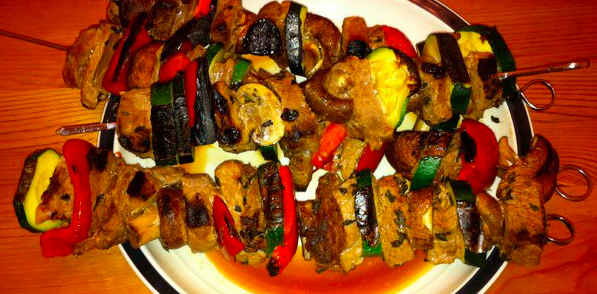I’m on a very strict meal plan.
I’ve been eating grass-fed ground beef, steak skewers, pecan-crusted chicken, pork and fish. I’ve been eating eggs, sausage, yams, deviled eggs, cabbage slaw and curry. I’ve been eating spice-rubbed chicken, salmon salad, and pear salad with balsamic vinegar. I’ve been eating shrimp with red onion, garlic, green bell peppers, salsa verde and chili powder -- served with romaine lettuce leaves, spinach, mango and lime. My fridge is filled to the brim with fresh, local, and organic fruit and vegetables of all colors, and my freezer is full of grass-fed beef, turkey, lamb, and chicken. I haven’t been scrimping on fat, either. I cook my nutrient-dense meals with coconut oil and olive oil, and eat plenty of avocados and macadamia nuts and even a little bit of almond butter.
What’s missing from this list? Added sugar. Alcohol. Milk. Cheese. Grains. Legumes. I’ve decided to spend 30 days eating a strict Paleo diet.
Popularized by Dr. Loren Cordain, the world’s leading expert on Paleolithic diets, (and more recently by Robb Wolf, author of New York Times bestseller The Paleo Solution: The Original Human Diet), this way of eating is based on research indicating that the best diet is the one we’re genetically adapted to. 10,000 years of agrarian eating is a small blip of time evolutionarily compared to the 2 - 5 million years we spent as hunter-gatherers, and research indicates that many people haven’t adequately adapted to Neolithic foods such as grains and dairy. Want to lose fat? Prevent disease? The Paleo diet can help. As an athlete, I’m always trying to find tricks to improve recovery and performance. Good nutrition is huge.
 But aren’t grains healthy? Actually, they’re not. They’re loaded with lectins (gluten in wheat, avenin in oats and zein in corn), which can create intestinal damage, inflammation, and poor digestion. Grains are loaded with phytic acid and other chemicals which strip nutrients such as magnesium, calcium, zinc, iron and B vitamins from your body. Grains also spike insulin levels. And they are not nutrient dense by any stretch of the imagination.
But aren’t grains healthy? Actually, they’re not. They’re loaded with lectins (gluten in wheat, avenin in oats and zein in corn), which can create intestinal damage, inflammation, and poor digestion. Grains are loaded with phytic acid and other chemicals which strip nutrients such as magnesium, calcium, zinc, iron and B vitamins from your body. Grains also spike insulin levels. And they are not nutrient dense by any stretch of the imagination.
Beans and legumes? They also have lectins (and, in the case of soybeans, phytoestrogens). Dairy? Many people react poorly to lactose, and casein allergies are not uncommon. Milk also causes insulin spikes.
Most people won’t try to argue the health benefits of sugar and alcohol, but will instead mention moderation. I agree. Ask me to give up chocolate and margaritas for life, and I’d run the other way. In fact, my first 30-day Paleo experiment included a bar or two of dark chocolate every week. But after attending an elucidating Whole9 Foundations of Nutrition workshop in Minneapolis, I’ve elected to participate in the stricter Whole30 program (as written by Dallas and Melissa Hartwig). Reading scientific studies is well and good, and I’m constantly reading about other experiences on the diet … but pushing my own nutritional reset button is a whole ‘nother story.
“Cut out all the inflammatory, insulin-spiking, calorie-dense but nutritionally sparse food groups for a full 30 days,” the Whole30, Version 3.11 reads. “Let your body heal and recover from whatever effects those foods may be provoking. Push the “reset” button with your metabolism, systemic inflammation, and the downstream effects of the food choices you’ve been making. Learn once and for all how the foods you’ve been eating are actually affecting your day to day life, and your long term health.” How could I resist?
Armed with the Whole30 Success Guide and a copy of Sarah Fragoso’s Everyday Paleo cookbook, I’m nearly a third way in to this 30-day challenge. The hardest parts? Sugar cravings, which I’ve been satiating with protein and fat. A few days of feeling sluggish as my body adjusts to the sudden drop in carbs. Having to cook every single meal. Wondering if it’s possible to hang out with friends without drinking. Recognizing my addiction to chewing gum (and having to brush my teeth way more than twice a day due to paranoia). The best parts? I’m digesting my food a lot better. My energy feels more steady. I’m sleeping better. And I’m psyched to slowly introduce certain foods again after this shindig is over, so I can figure out how it’s actually affecting me.
Follow my weekly progress on my blog, Yael Writes, to stay posted. (Here’s the original post and the week 1 recap to get you started!)
 Yael Grauer is a freelance food writer and managing editor of the Performance Menu: Journal of Health and Athletic Excellence. She has a penchant for chocolate and steak. Check out her latest blog posts and writing portfolio at Yael Writes.
Yael Grauer is a freelance food writer and managing editor of the Performance Menu: Journal of Health and Athletic Excellence. She has a penchant for chocolate and steak. Check out her latest blog posts and writing portfolio at Yael Writes.




